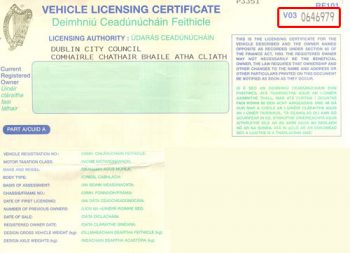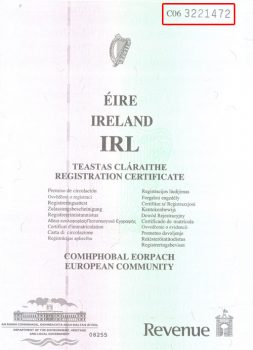What is the Vehicle Registration Certificate or Logbook?
The "Logbook", AKA the Vehicle Registration Certificate or Vehicle Licensing Certificate
The documentation certifying ownership of a vehicle will be in the form of a Vehicle Registration Certificate (VRC) or Vehicle Licensing Certificate (VLC). These documents are also commonly known as the "Logbook". Which document your vehicle will have depends on when the last change of ownership was completed or the age of the vehicle. The Vehicle Registration Certificate (VRC) is the newer document and the Vehicle Licensing Certificate (VLC) is the older form of this ownership document.
The registration certificate number will be displayed in one of the two ways shown below.
Vehicle Registration Certificate (VRC)
Vehicle Licensing Certificate (VLC)

For further information on these documents and how they relate to the change of ownership of a car please see the Citizens Information Website.
What is the process of obtaining a vehicle registration certificate in Ireland?
- Pre-Registration Procedures:
- Vehicle Inspection: Before a vehicle is registered, it may have to undergo an inspection, especially if it's imported.
- Pay VRT (Vehicle Registration Tax): If the vehicle is imported or hasn’t been previously registered in Ireland, you'll likely have to pay VRT. After the inspection, you will be told how much VRT you owe.
- Vehicle Registration:
- Visit a National Car Testing Service (NCTS) centre. You'll need to bring several documents with you, including proof of vehicle ownership, proof of your identity, and documents related to the vehicle (like an invoice).
- At the NCTS centre, after your vehicle is inspected and VRT is paid, the vehicle will be registered.
- Vehicle Registration Certificate:
- After the registration process, the NCTS will issue a Registration Number for the vehicle.
- The Vehicle Registration Certificate (VRC) will be posted to the registered owner by the Driver and Vehicle Computer Services Division of the Department of Transport. This can take a few weeks.
- If you purchase a used vehicle that's already registered in Ireland, you and the seller must complete the change of ownership process to get a new VRC. This can be done online or using the appropriate section of the VRC, which the seller sends to the Department of Transport.
- Motor Tax:
- After registering, you must also pay motor tax on the vehicle. You'll need the VRC when you're taxing the vehicle for the first time.
- Insurance:
- Ensure you have the necessary insurance coverage for your vehicle.
- Update in Personal Details:
- If your personal details change, like your address, it's essential to inform the Driver and Vehicle Computer Services Division to get an updated VRC.
How do you transfer the Vehicle Registration Certificate?
Transferring a vehicle registration in Ireland typically involves changing the registered owner of a vehicle. If you're buying or selling a car or you've received or given a car as a gift, it's crucial to ensure the registration is transferred to reflect the new owner.
- Vehicle Registration Certificate (VRC):
- The seller should provide the buyer with the Vehicle Registration Certificate.
- The new owner details should be filled out on the back of this certificate.
- Both the buyer and seller should sign this section.
- Notify the National Driver Licence Service (NDLS):
- Within 10 days of the transfer, the new owner should send the completed VRC to the Driver and Vehicle Computer Services Division of the Department of Transport, Tourism and Sport.
- If this is not done within 10 days, there may be a penalty.
- Motor Tax:
- The new owner should re-tax the vehicle in their name as soon as possible. This can be done online or at the local motor tax office.
- Insurance:
- Make sure the vehicle is insured in the new owner's name before it's driven. It's illegal to drive without insurance in Ireland.
- NCT (National Car Test):
- If the car is four years old or older, it will require an NCT. If the car doesn’t have a current NCT certificate, the new owner should book it for an NCT as soon as possible.
- Proof of Identity and PPS Number:
- When transferring ownership, the new owner might need to provide proof of identity and their PPS number, especially if the change of ownership is done at a public services office.
- Payment:
- There is no fee for changing ownership unless the transaction is seen as a sale. In that case, Vehicle Registration Tax (VRT) might be applicable depending on the circumstances. However, there are fees associated with taxing the vehicle and the NCT.
- For Vehicles From Outside of Ireland:
- If you're importing a car from outside of Ireland, there are additional steps and requirements, including the need to pay VRT and possibly VAT. You'll also need an inspection of the vehicle to get it registered in Ireland.
Remember, regulations and processes can change over time. Always consult with the official NDLS website or other Irish government sources for the most up-to-date information.
